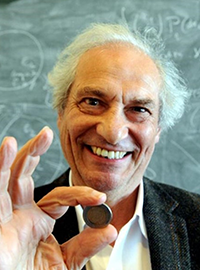ENSPM 2021 Talk
Title: GAMBLER’S RUIN AND THE ICM
Abstract: Picture three gambler’s with A, B and C $ respectively. Each time, a pair of gamblers are chosen at random, a fair coin is flipped and 1$ is transferred as the coin comes up heads or tails. Eventually, one of the gamblers is eliminated and two play the game until one winds up with A+B+C. In joint work with Stew Ethier, we study ‘what happens?” how long until the first gamber is eliminated? When this happens, how is the amount left distributed? And, how do the answers depend on A, B, C? These questions are interesting in tournament poker where the chances depend on the initial stack sizes, A,B,C but the winner and runner up get fixed prizes. then the chances of the different elimination orders (eg the chance that say 3 is eliminated first then 1 leaving 2 with all the cash) become important. If you want a puzzle, suppose A=B=1 and C=998 what is the chance that C is eliminated first?
The mathematical tools used are adapted from classical geometric analysis: Whitney covers, John and inner regular domains, moderate growth, Nash-Sobolev estimates. Of course with a good dose of probability theory mixed in. Actual computation involves a sojourn into modern numerical analysis. I will try to explain things to a general audience. Throughout, results are illustrated with data from the final tournaments in the World Series of Poker.
Persi Diaconis (Stanford University, USA)
Persi Diaconis is an American mathematician of Greek descent and former professional magician. He is the Mary V. Sunseri Professor of Statistics and Mathematics at Stanford University. He first taught at Stanford in 1974, moved to Harvard mathematics department in 1984, moving back to Stanford in 1998.
Trained as both a mathematician and a statistician, Diaconis wrote a seminal book on the use of Group theory in Probability and Statistics and has spent more than 30 years working with many students and co-authors studying convergence times of Monte Carlo Markov chains using probability theory and group theory. Answering questions such as how long does one have to run a Markov chain until it converges to its stationary distribution, an important question in modern Bayesian statistics. He is well known for the theorem that 7 shuffles are necessary to randomize a deck of cards by riffle shuffles. Diaconis wrote many papers with David Freedman about de Finetti’s theorem and the underpinnings of modern Bayesian statistics. He teaches in three departments at Stanford University, Mathematics, Statistics and the Philosophy department where he teaches a course with Bryan Skyrms based on his book “Ten Great Ideas about Chance”. He has written more than 250 scholarly articles and book chapters and is famous for his talks and exposition that cross different fields of mathematics; from algebra and geometry to probability and statistics. He was an early winner of the MacArthur “genius” grant in 1982, an IMS Wald lecturer in 1987, an ICM plenary speaker in 1998, the AMS Gibbs lecturer in 1997 and holds honorary degrees from the Universities of Toulouse, Chicago, Athens, Uppsala, Queen Mary, University of London and St Andrews.
More info >


